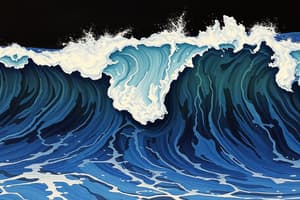Podcast
Questions and Answers
What is the relationship between frequency and wavelength?
What is the relationship between frequency and wavelength?
- Higher frequency corresponds to longer wavelength.
- Higher frequency corresponds to shorter wavelength. (correct)
- Frequency and wavelength are not related.
- Frequency is the inverse of wavelength.
What is the unit of measurement for frequency?
What is the unit of measurement for frequency?
- Meters (m)
- Seconds (s)
- Wavelength (λ)
- Hertz (Hz) (correct)
What does 1 Hertz equal to?
What does 1 Hertz equal to?
- 1m
- 1λ
- 1s
- 1/s (correct)
If a wave has a frequency of 10 Hz, how many waves pass a given point in one second?
If a wave has a frequency of 10 Hz, how many waves pass a given point in one second?
Which of the following correctly describes the relationship between wavelength and frequency?
Which of the following correctly describes the relationship between wavelength and frequency?
What is wave speed?
What is wave speed?
What factors affect the speed of a wave?
What factors affect the speed of a wave?
If a wave has a high frequency, what can be said about its wavelength?
If a wave has a high frequency, what can be said about its wavelength?
Which of the following is NOT a factor that affects wave speed?
Which of the following is NOT a factor that affects wave speed?
What does rarefaction refer to in the context of longitudinal waves?
What does rarefaction refer to in the context of longitudinal waves?
What does amplitude measure in a wave?
What does amplitude measure in a wave?
Which of the following best describes a transverse wave?
Which of the following best describes a transverse wave?
What does the wavelength (λ) of a wave represent?
What does the wavelength (λ) of a wave represent?
In which type of wave is the amount of compression a defining feature?
In which type of wave is the amount of compression a defining feature?
In which medium do mechanical waves travel fastest?
In which medium do mechanical waves travel fastest?
Why do mechanical waves travel faster in warmer mediums?
Why do mechanical waves travel faster in warmer mediums?
Which statement is true about the travel of mechanical waves?
Which statement is true about the travel of mechanical waves?
What is the correct order of mediums regarding the speed of mechanical waves, from fastest to slowest?
What is the correct order of mediums regarding the speed of mechanical waves, from fastest to slowest?
How does the closeness of particles in a medium affect the speed of mechanical waves?
How does the closeness of particles in a medium affect the speed of mechanical waves?
What occurs when two or more waves subtract from one another?
What occurs when two or more waves subtract from one another?
Which statement best describes constructive interference?
Which statement best describes constructive interference?
If two waves interfere such that their peaks and troughs perfectly align, what type of interference is being exhibited?
If two waves interfere such that their peaks and troughs perfectly align, what type of interference is being exhibited?
What term describes the energy-carrying packets associated with electromagnetic waves?
What term describes the energy-carrying packets associated with electromagnetic waves?
How does interference affect the amplitude of the resulting wave?
How does interference affect the amplitude of the resulting wave?
Which statement about electromagnetic waves is true?
Which statement about electromagnetic waves is true?
Which of the following is NOT a characteristic of interference between waves?
Which of the following is NOT a characteristic of interference between waves?
What is the relationship between electromagnetic waves and electromagnetic radiation?
What is the relationship between electromagnetic waves and electromagnetic radiation?
How can electromagnetic waves be described in terms of energy?
How can electromagnetic waves be described in terms of energy?
What is a key characteristic of photons?
What is a key characteristic of photons?
Flashcards
Frequency (f)
Frequency (f)
The number of waves that pass a given point in one second.
Hertz (Hz)
Hertz (Hz)
Unit of measurement for frequency.
1 Hertz
1 Hertz
1 Hertz represents one wave passing a point in one second.
Period (T)
Period (T)
Signup and view all the flashcards
Wavelength (λ)
Wavelength (λ)
Signup and view all the flashcards
Wavelength
Wavelength
Signup and view all the flashcards
Frequency
Frequency
Signup and view all the flashcards
Wave Speed
Wave Speed
Signup and view all the flashcards
Inverse Relationship between Wavelength and Frequency
Inverse Relationship between Wavelength and Frequency
Signup and view all the flashcards
Rarefaction
Rarefaction
Signup and view all the flashcards
Wave Speed and Medium
Wave Speed and Medium
Signup and view all the flashcards
Amplitude
Amplitude
Signup and view all the flashcards
Amplitude (Transverse Waves)
Amplitude (Transverse Waves)
Signup and view all the flashcards
Amplitude (Longitudinal Waves)
Amplitude (Longitudinal Waves)
Signup and view all the flashcards
Constructive Interference
Constructive Interference
Signup and view all the flashcards
Sound Waves Need a Medium
Sound Waves Need a Medium
Signup and view all the flashcards
Destructive Interference
Destructive Interference
Signup and view all the flashcards
Speed of Sound in Solids
Speed of Sound in Solids
Signup and view all the flashcards
Speed of Sound in Liquids
Speed of Sound in Liquids
Signup and view all the flashcards
What happens during constructive interference?
What happens during constructive interference?
Signup and view all the flashcards
Temperature and Sound Speed
Temperature and Sound Speed
Signup and view all the flashcards
What happens during destructive interference?
What happens during destructive interference?
Signup and view all the flashcards
Wave Interference
Wave Interference
Signup and view all the flashcards
Sound Can't Travel in a Vacuum
Sound Can't Travel in a Vacuum
Signup and view all the flashcards
Electromagnetic wave
Electromagnetic wave
Signup and view all the flashcards
Photon
Photon
Signup and view all the flashcards
Photons and Energy
Photons and Energy
Signup and view all the flashcards
Electromagnetic Radiation
Electromagnetic Radiation
Signup and view all the flashcards
Wave-Particle Duality
Wave-Particle Duality
Signup and view all the flashcards
Study Notes
Classifying Waves
- Waves are either electromagnetic or mechanical
- Electromagnetic waves can travel through a vacuum, like light waves
- Mechanical waves need a medium to travel, such as sound or water waves
- Medium: the substance a wave travels through, e.g., solids, liquids, or gases
Types of Waves
- Transverse Waves:
- Matter moves perpendicular to the wave's direction
- Examples include light waves, vibrations in string instruments, and water ripples
- Crest: Highest point of the wave
- Trough: Lowest point of the wave
- Longitudinal (Compressional) Waves:
- Matter moves parallel to the wave's direction
- Examples include sound waves, ultrasounds, and waves made with a slinky
- Compression: where particles are pushed closer together
- Rarefaction: where particles are spread further apart
Wave Properties
- Amplitude: The amount of energy a wave carries. Higher amplitude means more energy (for both transverse and longitudinal waves)
- Wavelength (λ): The distance between one point on a wave and the same point on the next wave (crest to crest, trough to trough, or a compression to a compression). Measured in meters (m).
- Period (T): The time it takes for one wavelength to pass a given point. Measured in seconds (s).
- Frequency (f): The number of waves that pass a given point in one second. Measured in Hertz (Hz). The relationship between frequency and period is: f = 1/T
- Wave Speed (v): How fast the wave travels— measured in meters per second (m/s). Wave speed is related to frequency and wavelength (v= f λ)
Wave Behavior
- Reflection: When a wave bounces off a surface. The angle of incidence equals the angle of reflection.
- Refraction: When a wave changes speed as it moves from one medium to another, causing it to bend. The greater the change in speed, the more the wave bends.
- Diffraction: When a wave bends around an obstacle or passes through an opening. The amount of diffraction depends on the size of the object and wavelength of the wave. Larger wavelengths diffract better.
- Absorption: When a wave's energy is transferred to the material it hits (i.e. the object absorbs the energy). Dark objects absorb more light than light objects.
- Interference: When two or more waves overlap and combine.
- Constructive Interference: waves add together to increase amplitude
- Destructive Interference: waves subtract from each other to reduce amplitude
- Standing Waves: Waves create a stationary pattern of nodes and antinodes. This occurs when waves traveling in opposite directions interfere.
- Resonance: An object vibrates at its natural frequency when impacted by a wave of the same frequency.
Electromagnetic Waves
- Electromagnetic waves do not need a medium; they can travel through a vacuum.
- Electromagnetic waves travel at 300,000,000 m/s in a vacuum
- Electromagnetic waves behave as waves and as particles (photons)
- The Electromagnetic Spectrum includes radio waves, microwaves, infrared, visible light, ultraviolet, X-rays, and gamma rays. Electromagnetic radiation has different wavelengths and frequencies which determine how it is used.
- Shorter wavelengths — higher frequencies — higher energy
Seeing
- The retina in the eye contains rods and cones that are receptive to different wavelengths and intensities of light
- Rods detect low light levels (for night vision)
- Cones detect colour in brighter conditions.
- Lenses focus light onto the retina.
Studying That Suits You
Use AI to generate personalized quizzes and flashcards to suit your learning preferences.




